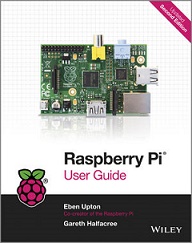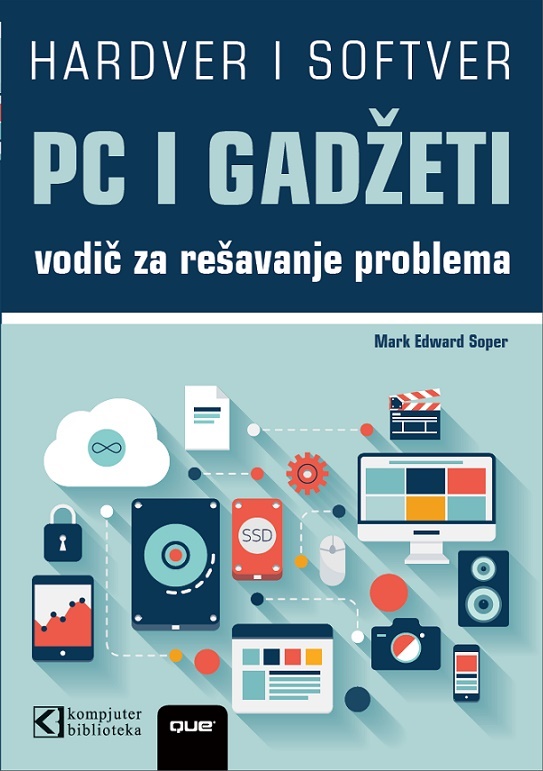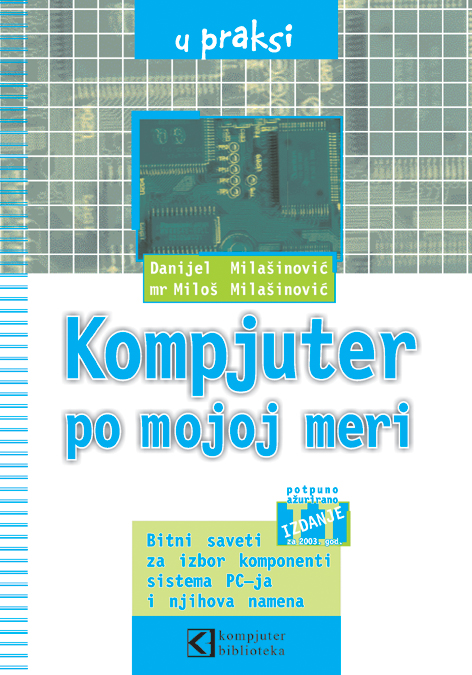
Autor: Eben Upton, Gareth Halfacree
Broj strana: 312
ISBN broj: 9781118795484
Izdavač:
WILEY ![]()
Godina izdanja: 2014.
 |
 |
 |
 |
 |
||||
The essential guide to getting started with the Raspberry Pi
The Raspberry Pi has been a success beyond the dream of its creators. Their goal, to encourage a new generation of computer programmers who understand how computers work, is well under way.
Raspberry Pi User Guide 2e is the newest edition of the runaway bestseller written by the Pi’s co-creator, Eben Upton, and tech writer Gareth Halfacree. It contains everything you need to know to get the Pi up and running, including how to:
Updated to cover the release of the Camera Board, the introduction of the Pi Store, NOOBS and much more, Raspberry Pi User Guide 2nd edition is the perfect companion for getting the most out of the computing phenomenon, the Raspberry Pi.
Eben Upton is the co-creator of the Raspberry Pi board and the founder of the Raspberry Pi Foundation.
Gareth Halfacree is a freelance technology journalist, open source advocate and erstwhile sysadmin.
Programming Is Fun! 1
A Bit of History 3
So What Can You Do with the Raspberry Pi? 8
Part I: Connecting the Board
CHAPTER 1 Meet the Raspberry Pi 13
A Trip Around the Board 14
Model A 16
Model B 17
A History of Model B PCB Revisions 18
Revision 1 18
Revision 2 18
A Bit of Background 18
ARM versus x86 19
Windows versus Linux 20
CHAPTER 2 Getting Started with the Raspberry Pi 21
Connecting a Display 22
Composite Video 22
HDMI Video 23
DSI Video 24
Connecting Audio 24
Connecting a Keyboard and Mouse 25
Installing NOOBS on an SD Card 27
Connecting External Storage 28
Connecting the Network 29
Wired Networking 30
Wireless Networking 31
Connecting Power 32
Installing the Operating System 33
Installing Using NOOBS 33
Installing Manually 35
CHAPTER 3 Linux System Administration 41
Linux: An Overview 42
Linux Basics 44
Introducing Raspbian 45
About Raspbian’s Parent, Debian 49
Alternatives to Raspbian 49
Using External Storage Devices 50
Creating a New User Account 51
File System Layout 52
Logical Layout 53
Physical Layout 54
Installing and Uninstalling Software 55
Obtaining Software from the Pi Store 55
Obtaining Software from Elsewhere 57
Finding the Software You Want 58
Installing Software 59
Uninstalling Software 61
Upgrading Software 61
Shutting the Pi Down Safely 62
CHAPTER 4 Troubleshooting 63
Keyboard and Mouse Diagnostics 64
Power Diagnostics 65
Display Diagnostics 67
Boot Diagnostics 68
Network Diagnostics 68
The Emergency Kernel 71
CHAPTER 5 Network Configuration 73
Wired Networking 74
Wireless Networking 77
Installing Firmware 78
Connecting to a Wireless Network via wpa_gui 82
Connecting to a Wireless Network via the Terminal 85
CHAPTER 6 The Raspberry Pi Software Configuration Tool 93
Running the Tool 94
The Setup Options Screen 95
1 Expand Filesystem 95
2 Change User Password 96
3 Enable Boot to Desktop 96
4 Internationalisation Options 97
5 Enable Camera 99
6 Add to Rastrack 99
7 Overclock 100
8 Advanced Options 101
9 About raspi-config 105
CHAPTER 7 Advanced Raspberry Pi Configuration 107
Editing Configuration Files via NOOBS 108
Hardware Settings—configtxt 110
Modifying the Display 111
Boot Options 114
Overclocking the Raspberry Pi 114
Disabling L2 Cache 118
Enabling Test Mode 119
Memory Partitioning 119
Software Settings—cmdlinetxt 120
Part II: Building a Media Centre, Productivity Machine or Web Server
CHAPTER 8 The Pi as a Home Theatre PC 125
Playing Music at the Console 126
Dedicated HTPC with Raspbmc 128
Streaming Internet Media 129
Streaming Local Network Media 131
Configuring Raspbmc 133
CHAPTER 9 The Pi as a Productivity Machine 135
Using Cloud-Based Apps 136
Using LibreOffice 139
Image Editing with The Gimp 141
CHAPTER 10 The Pi as a Web Server 145
Installing a LAMP Stack 146
Installing WordPress 150
Part III: Programming with the Raspberry Pi
CHAPTER 11 An Introduction to Scratch 157
Introducing Scratch 158
Example 1: Hello World 159
Example 2: Animation and Sound 162
Example 3: A Simple Game 165
Robotics and Sensors 171
Sensing with the PicoBoard 171
Robotics with LEGO 171
Further Reading 172
CHAPTER 12 An Introduction to Python 173
Introducing Python 174
Example 1: Hello World 174
Example 2: Comments, Inputs, Variables and Loops 180
Example 3: Gaming with pygame 184
Example 4: Python and Networking 193
Further Reading 199
Part IV: Hardware Hacking
CHAPTER 13 Learning to Hack Hardware 203
Electronic Equipment 204
Reading Resistor Colour Codes 206
Sourcing Components 208
Online Sources 208
Offline Sources 209
Hobby Specialists 209
Moving Up From the Breadboard 210
A Brief Guide to Soldering 213
CHAPTER 14 The GPIO Port 219
Identifying Your Board Revision 220
GPIO Pinout Diagrams 220
GPIO Features 222
UART Serial Bus 222
I2C Bus 223
SPI Bus 223
Using the GPIO Port in Python 223
GPIO Output: Flashing an LED 224
GPIO Input: Reading a Button 228
CHAPTER 15 The Raspberry Pi Camera Module 233
Why Use the Camera Module? 234
Installing the Camera Module 235
Enabling Camera Mode 238
Capturing Stills 239
Recording Video 242
Command-Line Time-Lapse Photography 243
CHAPTER 16 Add-on Boards 249
Ciseco Slice of Pi 250
Adafruit Prototyping Pi Plate 254
Fen Logic Gertboard 257
Part V: Appendixes
APPENDIX A Python Recipes 265
Raspberry Snake (Chapter 12, Example 3) 266
IRC User List (Chapter 12, Example 4) 268
GPIO Input and Output (Chapter 14)270
APPENDIX B Camera Module Quick Reference 271
Shared Options 272
Raspistill Options 275
Raspivid Options 276
Raspiyuv Options 276
APPENDIX C HDMI Display Modes 277
Index 283
Budite prvi koji će ostaviti komentar.

Popust cena:
2280.00 rsd

Popust cena:
440.00 rsd
© Sva prava pridržana, Kompjuter biblioteka, Beograd, Obalskih radnika 4a, Telefon: +381 11 252 0 272 |
||